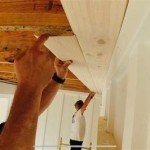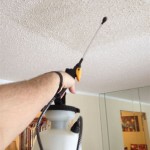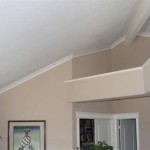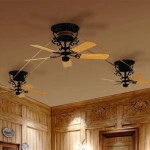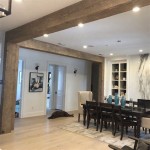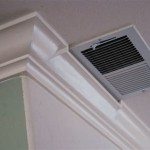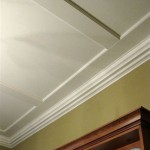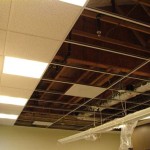How to Install Crown Molding on Angled Ceilings
Installing crown molding adds a touch of elegance and sophistication to any room. However, when dealing with angled ceilings, the installation process becomes significantly more complex than with standard 90-degree corners. Angled ceilings, often found in attics, vaulted rooms, or rooms with dormers, present unique challenges in achieving seamless and professional-looking results. This article provides a comprehensive guide on how to install crown molding on angled ceilings, covering everything from planning and measuring to cutting and installing the molding itself.
Successfully installing crown molding on angled ceilings requires meticulous planning, accurate measurements, and precise cutting techniques. Unlike standard corners which typically involve 45-degree cuts, angled ceilings necessitate calculating the specific angles required for each joint. Failure to do so will result in gaps, misalignments, and an unprofessional finished product. This guide outlines the necessary steps and considerations to ensure a successful crown molding installation on angled ceilings.
Understanding the Challenges of Angled Ceilings
The primary challenge in installing crown molding on angled ceilings lies in the non-standard angles involved. Unlike a typical 90-degree corner, the angles between the ceiling and the wall, and consequently the angles required for the crown molding joints, will vary. These angles must be accurately measured and calculated to ensure a snug and seamless fit. Furthermore, the method of cutting the crown molding also differs. While techniques like coped joints can be used for inside corners, they require a high degree of skill and may not always be suitable for the complex angles found in angled ceilings.
Another challenge related to angled ceilings is the potential for inconsistencies. Irregularities in the wall and ceiling surfaces, even slight ones, can compound the difficulties of achieving a perfectly aligned installation. It is important to identify and address any such imperfections before proceeding with the installation process. This may involve shimming, sanding, or other corrective measures to create a level and consistent surface.
Finally, the sheer complexity of the angles involved can make it difficult to visualize the final result. Careful planning and the use of mock-ups or templates can be invaluable in ensuring that the crown molding is properly positioned and that the joints align correctly. This is particularly important for complex angled ceilings with multiple intersecting planes.
Preparing for Installation
Before starting the installation, it is crucial to gather the necessary tools and materials. This includes the crown molding itself, a measuring tape, a protractor or angle finder, a miter saw, a coping saw (optional), a level, a stud finder, construction adhesive, caulk, wood filler, a nail gun or hammer and nails, safety glasses, and a dust mask.
The first step in preparing for installation is to accurately measure the angles of the corners where the crown molding will be installed. An angle finder or protractor can be used to determine the angle between the wall and the ceiling at each corner. For more complex angles, it may be necessary to use a combination square or T-bevel to transfer the angle to a piece of paper or cardboard for easier measurement.
Once the angles have been measured, they must be bisected to determine the required miter angle for each piece of crown molding. For example, if the angle between the wall and the ceiling is 120 degrees, the miter angle for each piece of crown molding would be 60 degrees. It is important to note that this is a simplified example, and the actual calculations may be more complex depending on the spring angle of the crown molding.
The spring angle refers to the angle at which the crown molding sits against the wall and ceiling. Different crown molding profiles have different spring angles, which must be taken into account when calculating the miter angles. Many online calculators and guides are available to assist with these calculations.
After determining the required miter angles, mark the locations of the wall studs using a stud finder. This will ensure that the crown molding is securely attached to the wall. It is also important to identify any obstructions, such as electrical wiring or plumbing, that may interfere with the installation. If necessary, relocate these obstructions or adjust the installation plan accordingly.
Cutting and Installing the Crown Molding
With the angles measured and the materials prepared, the next step is to cut the crown molding. Using a miter saw, carefully set the blade angle to the calculated miter angle. It is crucial to use a sharp blade to ensure clean and accurate cuts. When cutting the crown molding, it is important to position it in the miter saw in the same orientation as it will be installed on the wall. This is typically done by placing the crown molding flat against the saw fence and the table, with the top edge against the fence.
For inside corners, the crown molding pieces should be cut so that they meet at a point. For outside corners, the crown molding pieces should be cut so that they overlap slightly. It is often helpful to cut a test piece of crown molding to verify the accuracy of the miter angle before cutting the final pieces. If necessary, adjust the miter angle slightly to achieve a perfect fit.
Once the crown molding pieces have been cut, apply a bead of construction adhesive to the back of each piece. This will help to secure the crown molding to the wall and ceiling. Position the crown molding against the wall and ceiling, aligning it with the marked stud locations. Use a nail gun or hammer and nails to attach the crown molding to the wall studs. Be sure to drive the nails at an angle to ensure a secure hold.
For long runs of crown molding, it may be necessary to join multiple pieces together. This can be done using a scarf joint, which involves cutting the ends of the two pieces at a 45-degree angle and overlapping them. Apply construction adhesive to the joint and secure it with nails.
After the crown molding has been installed, fill any nail holes or gaps with wood filler. Allow the wood filler to dry completely, and then sand it smooth. Finally, caulk the seams between the crown molding and the wall and ceiling to create a seamless finish. Paint or stain the crown molding to match the existing trim in the room.
Dealing with Complex Angles and Curves
In some cases, angled ceilings may involve complex angles or curves that cannot be easily accommodated with straight crown molding. In these situations, there are several options to consider. One option is to use flexible crown molding, which is made from a pliable material that can be bent to conform to curved surfaces. Flexible crown molding is typically more expensive than standard crown molding, but it can be a good solution for challenging installations.
Another option is to create custom-made crown molding using a router and a template. This involves creating a template of the desired crown molding profile and then using a router to cut the profile from a piece of wood. This method allows for complete customization of the crown molding profile, but it requires a high degree of skill and experience.
For complex angles, it may be necessary to use a combination of different techniques. For example, you might use straight crown molding for the majority of the installation and then use flexible crown molding or custom-made crown molding to fill in the gaps in the corners. The key is to be creative and resourceful and to find a solution that works for your specific situation.
When dealing with curves, consider using small, incremental cuts to gradually shape the crown molding to the desired contour. This approach allows for greater control and reduces the risk of over-bending or breaking the molding. Patience and careful attention to detail are essential for achieving a professional-looking result on curved surfaces.
Regardless of the technique used, it is important to take your time and work carefully. Installing crown molding on angled ceilings is a challenging task, but with careful planning and execution, it is possible to achieve a beautiful and professional-looking result.
The use of specialized tools, such as a digital angle finder or a laser level, can significantly improve accuracy and efficiency when working with complex angles. These tools can help to ensure that the crown molding is properly aligned and that the joints are perfectly matched.
Finally, remember to always prioritize safety. Wear safety glasses to protect your eyes from flying debris, and use a dust mask to avoid inhaling dust. When using power tools, follow the manufacturer's instructions carefully and take all necessary precautions to prevent accidents.

Crown Moulding On Angled Ceiling Sawdust Girl

Crown Molding On Angled Ceilings Makely

Installing Crown Moulding Part Two Canadian Woodworking

Crown Moulding On Angled Ceiling Sawdust Girl

Installing Crown Moulding On A Sloped Ceiling Doityourself Com Community Forums

How To Install Crown Molding On Vaulted Or Cathedral Ceilings The Joy Of Moldings

Install Crown Molding Cathedral Vaulted Ceiling

Installing Crown Molding Around A Cathedral Ceiling Fine Homebuilding

Crown Moulding On Angled Ceiling Sawdust Girl

How To Install Crown Molding On A Vaulted Cathedral Ceiling Without Transition Piece
Related Posts

